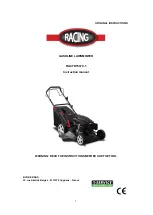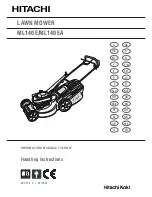
15
recommended as it may cause a build
‐
up of condensation resulting in corrosion of the
mower.
Extended shutdown and winter storage
Thoroughly clean the mower. Ideally, run the engine outdoors until the fuel tank is empty.
Alternatively, empty any remaining fuel using a fuel suction pump.
Dispose of discarded fuel safely and responsibly, remembering that petrol vapours can
cause explosion or fire. Run the engine until any remaining fuel is consumed. Allow the
engine to cool. Check the condition and cleanliness of the air cleaner. Remove the spark
plug from the engine and pour a tablespoon of engine oil into the cylinder. Gently pull the
starter rope several times to turn over the engine, distributing the oil to protect the cylinder
over winter. Replace and tighten the spark plug.
At the start of the new season
Remove the spark plug and gently clean off any carbon deposits from the tip with a small
copper wire brush, finishing off with petrol. Allow the spark plug to dry. Pull the starter rope
several times to expel excess oil from the cylinder. Replace and tighten the spark plug. Fill
the fuel tank with unleaded petrol. Turn over the engine until it starts.
Before transporting the mower
Thoroughly clean the mower. Empty the fuel tank using a suction pump. Dispose of
discarded fuel safely and responsibly, remembering that petrol vapours can cause
explosion or fire. Run the engine until any remaining fuel is consumed.
Allow the engine to cool. Remove the grass collection bag. Loosen the quick release and
fold down the top section of the handles taking care not to bend the cables.
To avoid scratching the mower, insert corrugated cardboard or similar padding between
the upper and lower handlebars and the engine.
Due to the mower’s weight, use ramps or seek assistance when lifting or loading the mower.
d. Mower maintenance
Cutting system
Before and after each mowing session, check that the blade, its attachment bolts and drive
shaft are not damaged or excessively worn. Never try to straighten a bent blade. Replace
a damaged, worn or bent blade as soon as possible. Use only genuine parts. Excessive
vibration when mowing is a good indication of a problem with the cutting system.
WARNING: Vibration from a bent or damaged blade can cause costly damage to the mower.
Working with an excessively worn blade wastes fuel and can lead to injury if the blade
becomes detached from the machine.
Warning: there is a danger about moving blade. Always handle the blade when it is totally
stopped. Wear protective gloves.
Sharpening the blade
For best mowing results, have the edges sharpened and the blade balanced at least once
a year by a specialist service dealer or agent.
Removing the blade
Wear appropriate protective gloves to prevent possible injury when handling the blade.
Disconnect the spark plug cap and tilt the mower on its side with air filter and carburettor
side uppermost.
Holding the blade firmly in one hand, use a spanner or socket to loosen the blade screw.
Mounting the blade
Wear appropriate protective gloves to prevent possible injury when handling the blade.
Disconnect the spark plug cap and tilt the mower on its side with air filter and carburettor
side uppermost.
Check that all components (the blade, key, blade holder, screws and washers).are present,
clean and in good condition.
Position the blade on its support with the cooling fins facing the engine.
Check the correct alignment and matching of pads with the blade. The blade must be



































